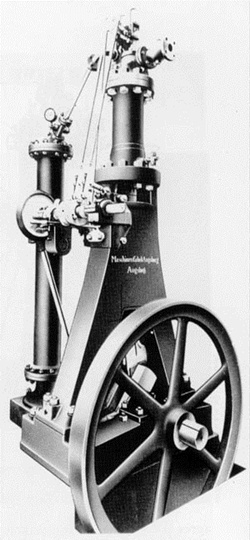The name ‘diesel’ comes from a Bavarian engineer, Rudolph Diesel (1858-1913) who developed a theory that revolutionized the engines of his day. He proposed an engine in which air was compressed to such a degree that this produced an extreme rise in temperature in the cylinder. When fuel is injected into the piston chamber at a critical point with this air, the fuel is ignited by the high temperature, causing an explosion to force the piston down. On February 27, 1892, Diesel filed for a patent at the Imperial Patent Office in Germany. Within a year, he was granted Patent No. 67207 for a “Working Method and Design for Combustion Engines – a new efficient, thermal engine.”

Diesel’s first diesel engine
The first fuel he used was coal dust, an ingredient which one of his financial backers had more than a slight surplus. This fuel source resulted turning the first engine into something akin to a hand grenade, almost killing Rudolph Diesel! However he persevered (but not with coal dust) and it was Diesel who first began to use ‘bio-diesel’ fuels successfully.
Diesel demonstrated his engine at the Exhibition Fair in Paris, France in 1898, where it used peanut oil – now considered the “original” bio-diesel. Like many ‘visionaries’ he hoped that his invention would benefit the ordinary man, particularly the smaller industries and farmers, and stop the dependence upon the petroleum industry.
Unfortunately Diesel did not live long enough to see the full force and longevity of his invention. With the First World War looming on the horizon, Rudolph Diesel did not agree with the politics of Germany and was reluctant to see his engine only used by their Naval fleet. With his political support directed towards France and Britain, he was on his way to England to arrange for them to use his engine when he inexplicably disappeared over the side of the ship in the English Channel. Did he jump? Or was he pushed? We will never know. All that we do know was that this was an untimely end for an engineering genius.
Work on refining the diesel principle continued, without its eponymous inventor. The largest problem facing the diesel engineers was the timing of the injection of diesel fuel into the cylinders. Too early and not enough power was produced, and the fuel poorly burned. Too late and a similar problem emerged. What made this an even greater conundrum was the fact that the point in the cycle changed as revolutions of the engine got faster. This was the problem in adapting diesel engines into the motor car, as up till the early 1920’s diesel engines were almost always used for slow revving marine engines (including the German submarine ‘Wolf Packs’ in WW I).
The 1920’s brought a new injection pump design from the Robert Bosch company, allowing the metering of fuel as it entered the engine without the need of pressurized air to propel the fuel mixture into the cylinder. This was a marked improvement.
The diesel engine was now small enough to be adapted for automotive use. 1923-1924 saw the first trucks built and shown at the Berlin Motor Fair. In 1936, Mercedes Benz built the first commercially produced automobile with a diesel engine – the Type 260D.
On the other side of the Atlantic, engineers were also refining the diesel process, with Clessie L Cummins, a mechanic-inventor who had been set up in business in 1919 by the investment banker William Glanton Irwin, purchasing manufacturing rights to the diesel engine from the Dutch licensor Hvid. He began by looking at the instability created by the fuel delivery system and developed a single disk system that measured the fuel injected.
With diesel engines now small enough to be installed in cars, Cummins began experimenting and marketing his engines. 1929 he installed a diesel engine in a limousine and took his financial backer, Irwin, for a ride, assuring further investment. He installed another in a Duesenberg, setting a speed record at Daytona (so the Le Mans Audi’s were not the first). He drove a truck with a Cummins diesel engine coast to coast for $11.22, and established an endurance record of 13,535 miles at Indianapolis Speedway in 1931. Cummins’ diesel engines proved themselves and trucks as well as other fleets began using them, and still do.




